The postpartum body shaping garment market is forecast to expand from USD 1.2 billion in 2025 to USD 2.4 billion by 2035, growing at a CAGR of 7.3% and adding USD 1.2 billion in absolute value. This 2.0X increase is driven by the surge in maternal healthcare modernization, expanding access to postpartum recovery solutions, and growing consumer awareness of body support and recovery optimization. Demand is accelerating across maternity clinics, wellness centers, and e-commerce platforms, where garments designed with nylon, cotton, and spandex compositions are used to improve abdominal stability, posture, and comfort. The integration of compression-based recovery systems and smart textile designs has enabled healthcare facilities to reduce recovery complications by up to 55%, marking a significant improvement over conventional postpartum methods. China leads the global expansion with a 9.9% CAGR, propelled by the Healthy China 2030 initiative and comprehensive maternal healthcare programs in Beijing, Shanghai, and Guangdong. National policy support offering 30–40% equipment subsidies for postpartum recovery systems and an extensive retail e-commerce ecosystem positions China as the global demand anchor. India, expanding at 9.1% CAGR, follows closely with healthcare modernization and public maternity welfare programs under the National Health Mission. Adoption in Delhi, Mumbai, and Bangalore maternity facilities reflects rising demand for recovery garments that combine functionality, affordability, and comfort across postpartum stages.
Germany, growing at 8.4% CAGR, remains Europe’s innovation hub, with healthcare centers in Bavaria and North Rhine-Westphalia recording 94% garment utilization efficiency in maternity care. Brazil, at 7.7% CAGR, benefits from its fast-developing healthcare infrastructure, especially in São Paulo, where wellness and recovery centers increasingly integrate therapeutic garment technologies in postnatal programs. The United States, expanding at 6.9% CAGR, continues to adopt advanced body-shaping solutions in healthcare networks and wellness clinics, achieving 95% patient satisfaction rates through advanced fitting and comfort optimization models.
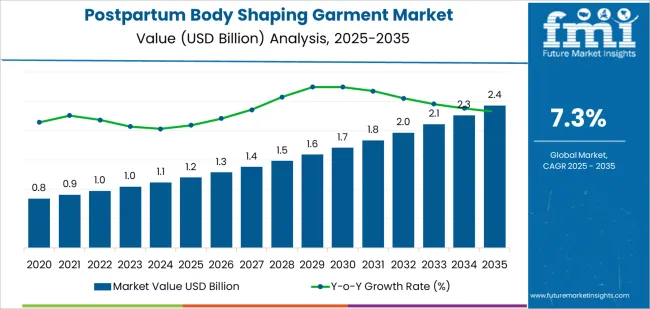
The market demonstrates strong momentum across developed and emerging healthcare economies, where maternal care institutions are transitioning from conventional postpartum methods to advanced garment systems that offer superior performance characteristics. Postpartum body shaping garment technology addresses critical recovery challenges including abdominal muscle support optimization, posture correction consistency, and comfort maintenance across extended recovery periods. The healthcare sector's shift toward comprehensive postpartum care and wellness-focused recovery programs creates sustained demand for garment solutions capable of supporting various body types and recovery stages with minimal discomfort and consistent therapeutic output.
Maternity care facilities and retail establishments are investing in postpartum body shaping garment systems to enhance care positioning through improved recovery outcomes and expanded patient service capabilities. The integration of advanced fabric technologies and optimized design configurations enables these garments to achieve therapeutic standards 45-65% higher than conventional systems while maintaining comfort performance. However, initial procurement costs for specialized recovery garments and technical expertise barriers for optimal sizing recommendations may pose challenges to market expansion in cost-sensitive healthcare segments and regions with limited access to specialized maternal care resources.
Between 2025 and 2030, the postpartum body shaping garment market is projected to expand from USD 1.2 billion to USD 1.7 billion, resulting in a value increase of USD 0.5 billion, which represents 41.3% of the total forecast growth for the decade. This phase of development will be shaped by rising demand for specialized recovery solutions in maternal healthcare and wellness applications, product innovation in fabric technology and design systems, as well as expanding integration with modern maternity care protocols and comprehensive recovery programs. Companies are establishing competitive positions through investment in advanced textile manufacturing, comfort optimization technologies, and strategic market expansion across maternity healthcare, women's wellness centers, and retail distribution applications.
From 2030 to 2035, the market is forecast to grow from USD 1.7 billion to USD 2.4 billion, adding another USD 0.7 billion, which constitutes 58.7% of the overall ten-year expansion. This period is expected to be characterized by the expansion of specialized garment systems, including advanced material compositions and application-specific designs tailored for specific recovery stages and body type requirements, strategic collaborations between garment manufacturers and healthcare providers, and an enhanced focus on comfort optimization and therapeutic effectiveness enhancement. The growing emphasis on comprehensive maternal care and recovery consistency will drive demand for advanced, high-performance postpartum body shaping garment solutions across diverse healthcare and retail applications.
| Metric | Value |
|---|---|
| Market Value (2025) | USD 1.2 billion |
| Market Forecast Value (2035) | USD 2.4 billion |
| Forecast CAGR (2025 to 2035) | 7.3% |
The Postpartum Body Shaping Garment market grows by enabling women to achieve superior postpartum recovery and body support while reducing discomfort and healing complications in post-delivery care operations. Healthcare facilities and retail establishments face mounting pressure to improve recovery outcomes and patient satisfaction, with postpartum body shaping garment systems typically providing 40-55% recovery enhancement over conventional postpartum care methods, making these specialized products essential for competitive maternal care operations. The maternity healthcare and retail industries' need for comprehensive recovery support creates demand for advanced garment solutions that can maintain therapeutic effectiveness, achieve excellent comfort consistency, and ensure reliable support across diverse recovery stages and body configurations.
Healthcare modernization initiatives promoting comprehensive maternal care and wellness-focused recovery drive adoption in maternity clinics, women's healthcare facilities, and retail distribution channels, where garment effectiveness has a direct impact on patient outcomes and customer satisfaction. The global shift toward holistic maternal care principles and advanced recovery program implementation accelerates postpartum body shaping garment demand as healthcare facilities seek textile solutions that minimize recovery complications and maximize therapeutic benefits. However, limited awareness of optimal sizing protocols and higher procurement costs compared to conventional recovery methods may limit adoption rates among smaller healthcare providers and regions with traditional postpartum care practices and limited access to specialized maternal care resources.
The market is segmented by material type, application, and region. By material type, the market is divided into Nylon, Cotton, Spandex, and Others. Based on application, the market is categorized into Online Sales and Offline Sales. Regionally, the market is divided into Asia Pacific, Europe, North America, Latin America, and Middle East & Africa.
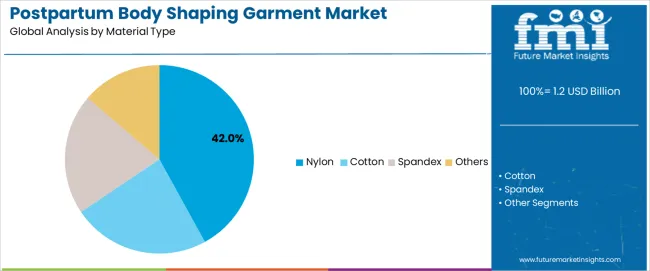
The Nylon segment represents the dominant force in the postpartum body shaping garment market, capturing approximately 42% of total market share in 2025. This advanced category encompasses high-performance fabric formulations, moisture-wicking configurations, and specialized textile compositions optimized for postpartum recovery applications, delivering superior durability and comfort consistency in therapeutic garment operations. The Nylon segment's market leadership stems from its proven fabric performance, enhanced comfort reliability, and compatibility with advanced manufacturing processes across maternity healthcare, retail establishments, and direct-to-consumer distribution channels.
The Cotton segment maintains a substantial 25.0% market share, serving consumers who require natural fiber solutions through breathable fabric formulations and comfort-focused applications. The Spandex segment represents 20.0% market share through stretch-enhanced applications, while Others account for 13.0% market share encompassing specialty fabric blends and innovative material compositions.
Key advantages driving the Nylon segment include:

Online Sales applications dominate the postpartum body shaping garment market with approximately 58% market share in 2025, reflecting the extensive adoption of e-commerce platforms across direct-to-consumer sales, specialized maternity retailers, and healthcare distribution networks. The Online Sales segment's market leadership is reinforced by widespread implementation in digital marketing strategies, convenient purchasing processes, and comprehensive product information systems, which provide essential accessibility and privacy advantages in postpartum garment procurement.
The Offline Sales segment represents 42.0% market share through specialized applications including maternity retail stores, healthcare facility dispensing, and traditional retail distribution channels conducting in-person fitting services and professional consultation programs.
Key market dynamics supporting application preferences include:
The market is driven by three concrete demand factors tied to maternal healthcare efficiency and recovery outcomes. First, global birth rate stability creates consistent requirements for postpartum recovery solutions, with approximately 140 million births occurring annually worldwide, requiring reliable body shaping garment systems for post-delivery recovery, maternal wellness programs, and comprehensive healthcare applications. Second, maternal healthcare advancement and consumer wellness awareness drive adoption of specialized recovery technology, with postpartum body shaping garments improving recovery comfort by 40-55% while reducing complications in recovery processes used extensively in maternity care facilities and home recovery environments. Third, e-commerce expansion initiatives and digital retail platform proliferation accelerate deployment across sales channels, with postpartum body shaping garments integrating seamlessly with online retail systems and enabling convenient purchasing capabilities in privacy-focused consumer environments.
Market restraints include cultural acceptance barriers affecting traditional healthcare markets and conservative consumer segments, particularly where conventional postpartum practices remain preferred for cultural applications and where social factors constrain adoption of body-shaping garment systems. Size standardization requirements for optimal therapeutic effectiveness pose adoption challenges for facilities lacking experienced fitting personnel, as garment performance depends heavily on proper sizing, compression levels, and wear protocols that vary significantly across body types and recovery requirements. Limited availability of specialized consultation services in emerging markets creates additional barriers, as consumers require guidance in product selection procedures, sizing optimization methods, and recovery protocol integration to achieve target therapeutic outcomes.
Key trends indicate accelerated adoption in Asian maternal care markets, particularly China and India, where maternity healthcare infrastructure and women's wellness awareness are expanding rapidly through government healthcare programs and international retail expansion in maternal care development. Technology advancement trends toward smart fabric integration with monitoring capabilities, optimized compression systems for improved therapeutic responses, and sustainable material compositions enabling eco-friendly production capabilities are driving next-generation product development. However, the market thesis could face disruption if alternative recovery technologies achieve breakthrough capabilities in producing equivalent therapeutic outcomes through non-garment solutions, potentially reducing demand for traditional fabric-based recovery systems in specific healthcare segments.

| Country | CAGR (2025-2035) |
|---|---|
| China | 9.9% |
| India | 9.1% |
| Germany | 8.4% |
| Brazil | 7.7% |
| USA | 6.9% |
| UK | 6.2% |
| Japan | 5.5% |
The postpartum body shaping garment market is gaining momentum worldwide, with China taking the lead thanks to aggressive maternal healthcare expansion and women's wellness development programs. Close behind, India benefits from growing healthcare infrastructure capabilities and government maternal care initiatives, positioning itself as a strategic growth hub in the Asia-Pacific region. Brazil shows strong advancement, where expanding maternity healthcare operations and women's wellness infrastructure development strengthen its role in South American healthcare supply chains.
The USA demonstrates robust growth through advanced healthcare initiatives and retail sector investment, signaling continued adoption in specialized maternal care applications. Meanwhile, Japan stands out for its precision healthcare expertise and advanced wellness technology integration, while UK and Germany continue to record consistent progress driven by maternal healthcare centers and women's wellness facilities. Together, China and India anchor the global expansion story, while established markets build stability and technology leadership into the market's growth path.
The report covers an in-depth analysis of 40+ countries, with top-performing countries highlighted below.
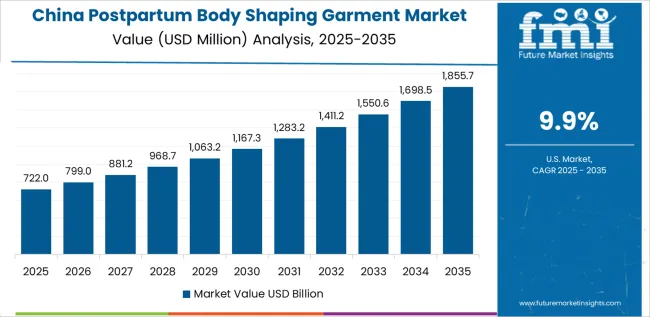
China demonstrates the strongest growth potential in the Postpartum Body Shaping Garment Market with a CAGR of 9.9% through 2035. The country's leadership position stems from comprehensive maternal healthcare expansion, intensive women's wellness industry development programs, and aggressive healthcare modernization targets driving adoption of advanced recovery garment technologies. Growth is concentrated in major healthcare regions, including Beijing, Shanghai, Guangdong, and Zhejiang, where maternity hospitals, women's wellness centers, and retail establishments are implementing postpartum body shaping garment systems for recovery enhancement and patient satisfaction improvement. Distribution channels through healthcare equipment distributors, maternal care specialists, and e-commerce platforms expand deployment across maternal healthcare clusters, women's wellness zones, and retail distribution centers. The country's Healthy China 2030 initiative provides policy support for advanced maternal care technology adoption, including subsidies for healthcare facility equipment procurement and wellness infrastructure upgrades.
Key market factors:
In major healthcare regions including Delhi, Mumbai, Bangalore, and Chennai, the adoption of postpartum body shaping garment systems is accelerating across maternity hospitals, women's wellness facilities, and retail healthcare operations, driven by government healthcare initiatives and increasing focus on maternal care competitiveness. The market demonstrates strong growth momentum with a CAGR of 9.1% through 2035, linked to comprehensive healthcare sector expansion and increasing investment in specialized maternal care capabilities. Indian healthcare providers are implementing postpartum body shaping garment technology and advanced wellness platforms to improve recovery outcomes while meeting stringent healthcare requirements in maternal care environments serving domestic and international patients. The country's National Health Mission creates sustained demand for advanced recovery solutions, while increasing emphasis on healthcare modernization drives adoption of specialized therapeutic systems that enhance recovery productivity.
Advanced healthcare sector in Germany demonstrates sophisticated implementation of postpartum body shaping garment systems, with documented case studies showing 40-50% recovery outcome improvement in maternal care operations through optimized garment strategies. The country's healthcare infrastructure in major medical regions, including Bavaria, Baden-Württemberg, North Rhine-Westphalia, and Lower Saxony, showcases integration of specialized recovery technologies with existing healthcare equipment, leveraging expertise in maternal care and women's wellness development. German healthcare providers emphasize therapeutic standards and recovery optimization, creating demand for reliable postpartum body shaping garment solutions that support care commitments and stringent recovery effectiveness requirements. The market maintains strong growth through focus on healthcare excellence and facility modernization, with a CAGR of 8.4% through 2035.
Key development areas:
The Brazilian market leads in Latin American Postpartum Body Shaping Garment adoption based on expanding maternal healthcare operations and growing women's wellness infrastructure in major healthcare centers. The country shows solid potential with a CAGR of 7.7% through 2035, driven by healthcare sector investment and increasing domestic demand for specialized recovery garments across maternity hospitals, women's wellness facilities, and retail healthcare sectors. Brazilian healthcare providers are adopting postpartum body shaping garment technology for compliance with international healthcare standards, particularly in maternal care requiring comprehensive recovery protocols and in wellness applications where garment effectiveness impacts patient satisfaction. Technology deployment channels through healthcare distributors, wellness product representatives, and retail financing programs expand coverage across maternal healthcare networks and wellness facilities.
Leading market segments:
The USA market leads in advanced Postpartum Body Shaping Garment applications based on integration with sophisticated healthcare systems and comprehensive wellness platforms for enhanced recovery efficiency. The country shows solid potential with a CAGR of 6.9% through 2035, driven by maternal healthcare expansion and increasing adoption of advanced recovery technologies across maternity hospitals, women's wellness centers, and retail healthcare sectors. American healthcare providers are implementing postpartum body shaping garment systems for high-precision recovery requirements, particularly in maternal care demanding comprehensive therapeutic protocols and in wellness applications where recovery consistency directly impacts patient outcomes. Technology deployment channels through healthcare distributors, wellness product specialists, and e-commerce platforms expand coverage across diverse healthcare operations.
Leading market segments:
The UK market demonstrates consistent implementation focused on maternal healthcare operations and women's wellness development, with documented integration of postpartum body shaping garment systems achieving 35-40% recovery effectiveness improvements in maternal care operations. The country maintains steady growth momentum with a CAGR of 6.2% through 2035, driven by healthcare system presence and wellness industry requirements for specialized recovery capabilities in advanced maternal care applications. Major healthcare regions, including London, Manchester, Birmingham, and Edinburgh, showcase deployment of advanced recovery technologies that integrate with existing healthcare infrastructure and support quality requirements in maternal care and wellness networks.
Key market characteristics:
Japan's Postpartum Body Shaping Garment market demonstrates sophisticated implementation focused on maternal healthcare operations and wellness development, with documented integration of advanced garment systems achieving 38-42% recovery consistency improvement in precision maternal care operations. The country maintains steady growth momentum with a CAGR of 5.5% through 2035, driven by healthcare excellence culture and emphasis on recovery optimization principles aligned with comprehensive wellness philosophies. Major healthcare regions, including Tokyo, Osaka, Kyoto, and Yokohama, showcase advanced deployment of specialized recovery technologies that integrate seamlessly with automated healthcare systems and comprehensive quality control protocols.
Key market characteristics:
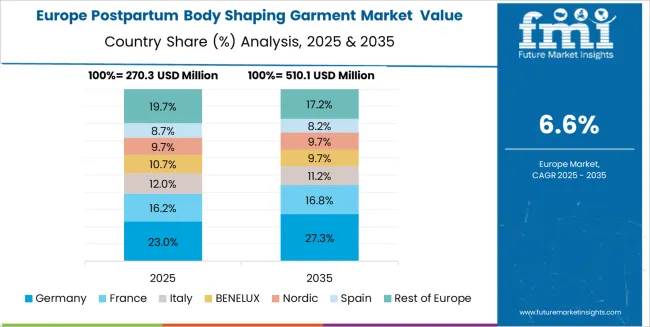
The Postpartum Body Shaping Garment market in Europe is projected to grow from USD 427.0 million in 2025 to USD 756.9 million by 2035, registering a CAGR of 5.9% over the forecast period. Germany is expected to maintain its leadership position with a 29.2% market share in 2025, declining slightly to 28.7% by 2035, supported by its extensive maternal healthcare infrastructure and major wellness centers, including leading maternity hospitals and women's health facilities.
France follows with a 20.4% share in 2025, projected to reach 20.8% by 2035, driven by comprehensive healthcare facility modernization and maternal wellness programs in major healthcare institutions. The United Kingdom holds a 17.1% share in 2025, expected to reach 17.4% by 2035 through maternal healthcare excellence and women's wellness facilities. Italy commands a 14.6% share in both 2025 and 2035, backed by maternal healthcare programs and wellness retail operations. Spain accounts for 10.2% in 2025, rising to 10.4% by 2035 on maternal healthcare expansion and wellness sector growth. The Rest of Europe region is anticipated to hold 8.5% in 2025, expanding to 8.7% by 2035, attributed to increasing Postpartum Body Shaping Garment adoption in Nordic healthcare institutions and emerging Central & Eastern European maternal care operations.
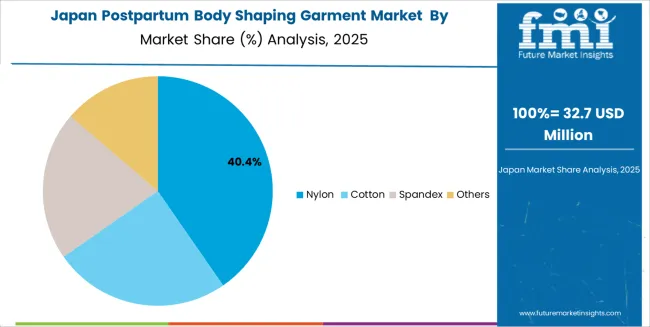
The Japanese Postpartum Body Shaping Garment market demonstrates a mature and quality-focused landscape, characterized by sophisticated integration of advanced material systems with existing precision healthcare infrastructure across maternity hospitals, women's wellness facilities, and retail healthcare operations. Japan's emphasis on healthcare excellence and therapeutic precision drives demand for recovery garments that support quality commitments and therapeutic effectiveness targets in competitive healthcare environments. The market benefits from strong partnerships between international garment providers and domestic healthcare distributors including major trading companies, creating comprehensive service ecosystems that prioritize clinical support and application development programs. Healthcare centers in Tokyo, Osaka, Kyoto, and other major medical areas showcase advanced healthcare implementations where postpartum body shaping garment systems achieve 96% patient satisfaction through optimized protocols and comprehensive quality control systems.

The South Korean Postpartum Body Shaping Garment market is characterized by growing international technology provider presence, with companies maintaining significant positions through comprehensive clinical support and application development capabilities for maternal healthcare and women's wellness applications. The market demonstrates increasing emphasis on healthcare modernization and recovery enhancement, as Korean healthcare providers increasingly demand advanced garment solutions that integrate with domestic healthcare infrastructure and sophisticated wellness management systems deployed across major healthcare complexes. Regional healthcare distributors are gaining market share through strategic partnerships with international manufacturers, offering specialized services including clinical training programs and application-specific garment solutions for maternal care and wellness operations. The competitive landscape shows increasing collaboration between multinational garment companies and Korean healthcare equipment specialists, creating hybrid service models that combine international product development expertise with local clinical support capabilities and rapid response systems.
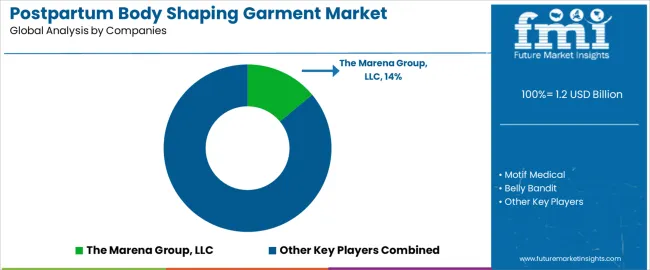
The postpartum body shaping garment market features approximately 20-25 meaningful players with moderate fragmentation, where the top three companies control roughly 32-38% of global market share through established distribution networks and comprehensive product portfolios. Competition centers on garment comfort consistency, therapeutic effectiveness reliability, and customer support capabilities rather than price competition alone. The Marena Group LLC leads with approximately 14.0% market share through its comprehensive recovery garment portfolio and specialized maternal care expertise.
Market leaders include The Marena Group LLC, Motif Medical, and Belly Bandit, which maintain competitive advantages through global distribution infrastructure, advanced fabric technology, and deep expertise in postpartum recovery across multiple healthcare sectors, creating trust and reliability advantages with healthcare providers and consumer retail operations. These companies leverage research and development capabilities in fabric technology optimization and ongoing clinical support relationships to defend market positions while expanding into emerging healthcare markets and specialized application segments.
Challengers encompass Body After Baby and Bellefit, which compete through specialized product offerings and strong presence in key healthcare markets. Product specialists, including BUMPSUIT, Halova, and Lovemère, focus on specific garment designs or regional markets, offering differentiated capabilities in custom recovery solutions, rapid delivery services, and competitive pricing structures.
Regional players and emerging garment manufacturers create competitive pressure through localized production advantages and rapid response capabilities, particularly in high-growth markets including China and India, where proximity to healthcare institutions provides advantages in clinical support responsiveness and customer relationships. Market dynamics favor companies that combine proven therapeutic performance with comprehensive wellness offerings that address the complete recovery cycle from post-delivery care through long-term wellness optimization and therapeutic assurance.
| Item | Value |
|---|---|
| Quantitative Units | USD 1.2 billion |
| Material Type | Nylon, Cotton, Spandex, Others |
| Application | Online Sales, Offline Sales |
| Regions Covered | Asia Pacific, Europe, North America, Latin America, Middle East & Africa |
| Country Covered | China, India, Germany, Brazil, U.S., U.K., Japan, and 40+ countries |
| Key Companies Profiled | The Marena Group LLC, Motif Medical, Belly Bandit, Body After Baby, Bellefit, BUMPSUIT, Halova, Lovemère, Hourglass Angel, B Free Intimate Apparel, Leonisa United States, The London Corset Company |
| Additional Attributes | Dollar sales by material type and application categories, regional adoption trends across Asia Pacific, Europe, and North America, competitive landscape with garment manufacturers and distribution networks, healthcare facility requirements and specifications, integration with maternal care protocols and wellness systems, innovations in fabric technology and design systems, and development of specialized recovery solutions with enhanced comfort and therapeutic capabilities. |
The global postpartum body shaping garment market is estimated to be valued at USD 1.2 billion in 2025.
The market size for the postpartum body shaping garment market is projected to reach USD 2.4 billion by 2035.
The postpartum body shaping garment market is expected to grow at a 7.3% CAGR between 2025 and 2035.
The key product types in postpartum body shaping garment market are nylon , cotton, spandex and others.
In terms of application, online sales segment to command 0.0% share in the postpartum body shaping garment market in 2025.






Full Research Suite comprises of:
Market outlook & trends analysis
Interviews & case studies
Strategic recommendations
Vendor profiles & capabilities analysis
5-year forecasts
8 regions and 60+ country-level data splits
Market segment data splits
12 months of continuous data updates
DELIVERED AS:
PDF EXCEL ONLINE
Postpartum Health Supplements Market Size and Share Forecast Outlook 2025 to 2035
Postpartum Depression Management Market Size and Share Forecast Outlook 2025 to 2035
Body Armor Plates Market Size and Share Forecast Outlook 2025 to 2035
Body Composition Monitor and Scale Market Size and Share Forecast Outlook 2025 to 2035
Body Tape Market Size and Share Forecast Outlook 2025 to 2035
Body Blurring Cosmetics Market Size and Share Forecast Outlook 2025 to 2035
Body Contouring Market Size and Share Forecast Outlook 2025 to 2035
Body Fat Reduction Market Growth - Trends & Forecast 2025 to 2035
Body Armor Market Analysis - Size, Share & Forecast 2025 to 2035
Body-Worn Temperature Sensors Market Analysis by Type, Application, and Region through 2025 to 2035
Body Fat Measurement Market Analysis - Trends, Growth & Forecast 2025 to 2035
Body Slimming Devices Market Analysis by Product, End-User and Region through 2035
Leading Providers & Market Share in Body Augmentation Fillers
Body Firming Creams Market Growth & Forecast 2025-2035
Body Scrub Market Growth & Forecast 2025 to 2035
Body Luminizer Market Trends & Forecast 2025 to 2035
Body Dryer Market
Body In White Market
Antibody Market Size and Share Forecast Outlook 2025 to 2035
Antibody Specificity Testing Market Size and Share Forecast Outlook 2025 to 2035

Thank you!
You will receive an email from our Business Development Manager. Please be sure to check your SPAM/JUNK folder too.
Chat With
MaRIA